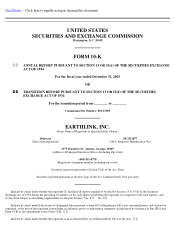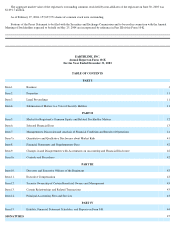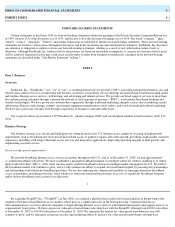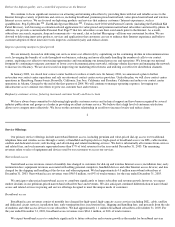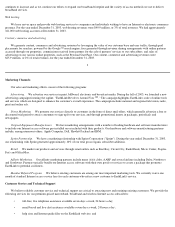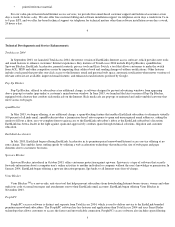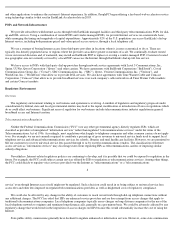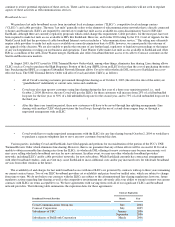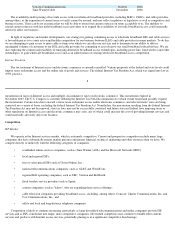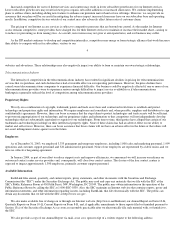Earthlink 2003 Annual Report Download - page 10
Download and view the complete annual report
Please find page 10 of the 2003 Earthlink annual report below. You can navigate through the pages in the report by either clicking on the pages listed below, or by using the keyword search tool below to find specific information within the annual report.
The availability and/or pricing of last mile access with our wholesale broadband providers, including ILECs, CLECs, and cable providers,
among others, at the expiration of current terms or tariffs cannot be assured, and may reflect regulatory or legislative as well as competitive and
business factors. There can be no assurance that we will be able to extend our current contracts on terms acceptable to us. The inability to
extend current contracts with last mile broadband access providers or to expand the availability of last mile broadband access could materially
adversely affect our business.
In light of regulatory and market developments, our strategy for gaining continuing access to wholesale broadband DSL and cable services
at favorable prices is to create active and healthy competition for our business between ILECs and cable providers in major markets. To do this,
we are attempting to gain access to more cable systems over which we can offer our services and to demonstrate our ability to deliver
meaningful volumes of customers to our DSL and cable providers by continuing to actively grow our retail broadband subscriber base. We are
also exploring the commercial feasibility of emerging alternative broadband access technologies, including power line, fixed wireless and other
technologies, to gain wholesale broadband access and as an added means of creating wholesale broadband access competition.
Internet Taxation
The tax treatment of Internet access and electronic commerce is currently unsettled. Various proposals at the federal and state levels could
impose taxes on Internet access and the online sale of goods and services. The federal Internet Tax Freedom Act, which was signed into law in
1998, placed a
8
moratorium on taxes on Internet access and multiple, discriminatory taxes on electronic commerce. This moratorium expired in
November 2003. The U.S. Congress is currently debating the Internet Tax Non
-Discrimination Act which would extend and possibly expand
the moratorium. Certain states have enacted various taxes on Internet access and/or electronic commerce, and selected states' taxes are being
contested on a variety of bases, including the federal Internet Tax Freedom Act. Nonetheless, the moratorium resulting from the federal Internet
Tax Freedom Act may not be renewed, state tax laws may not be successfully contested, and future state and federal laws imposing taxes or
other regulations on Internet access and electronic commerce may arise, any of which could increase the cost of providing Internet services and
could materially adversely affect our business.
Competition
ISP Market
We operate in the Internet services market, which is extremely competitive. Current and prospective competitors include many large
companies that have substantially greater market presence and greater financial, technical, marketing and other resources than we have. We
compete directly or indirectly with the following categories of companies:
•
Verizon Communications Inc.
October
2006
Time Warner Cable
December
2006
established online services companies, such as Time Warner (AOL) and the Microsoft Network (MSN);
• local and regional ISPs;
• free or value-priced ISPs such as United Online, Inc.;
• national telecommunications companies, such as AT&T and WorldCom;
• regional Bell operating companies, such as SBC, Verizon and BellSouth;
• fixed wireless service providers such as Sprint;
• content companies, such as Yahoo!, who are expanding their service offerings;
• cable television companies providing broadband access, including, among others, Comcast, Charter Communications, Inc. and
Cox Communications, Inc.; and
• utility and local and long-distance telephone companies.
Competition is likely to continue increasing, particularly as large diversified telecommunications and media companies provide ISP
services and as ISPs consolidate into larger, more competitive companies. Diversified competitors may continue to bundle other content,
services and products with Internet access services, potentially placing us at a significant competitive disadvantage.


